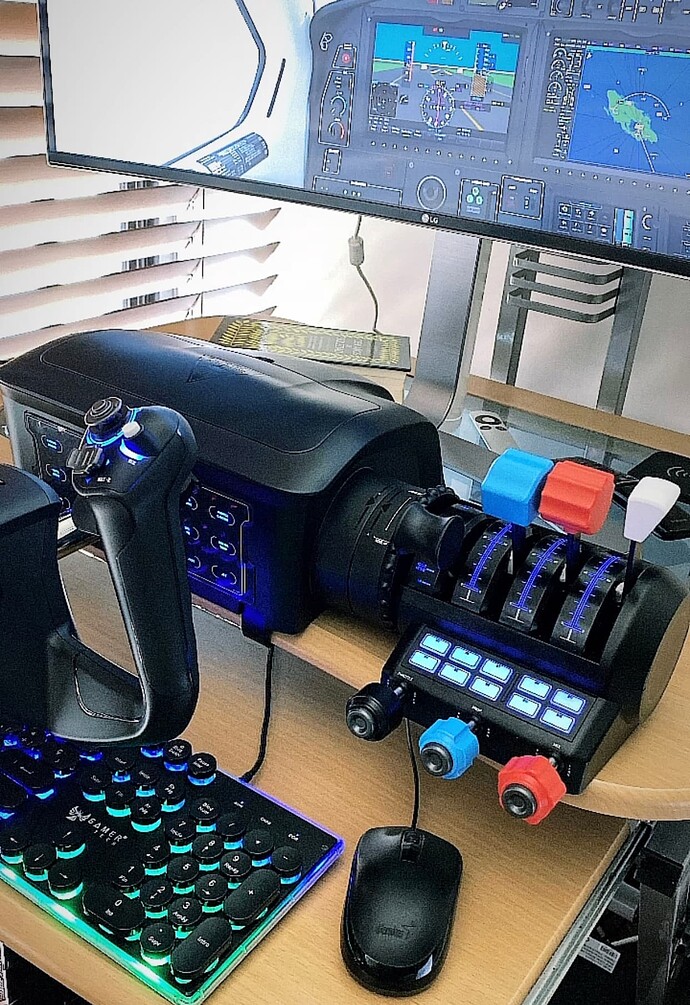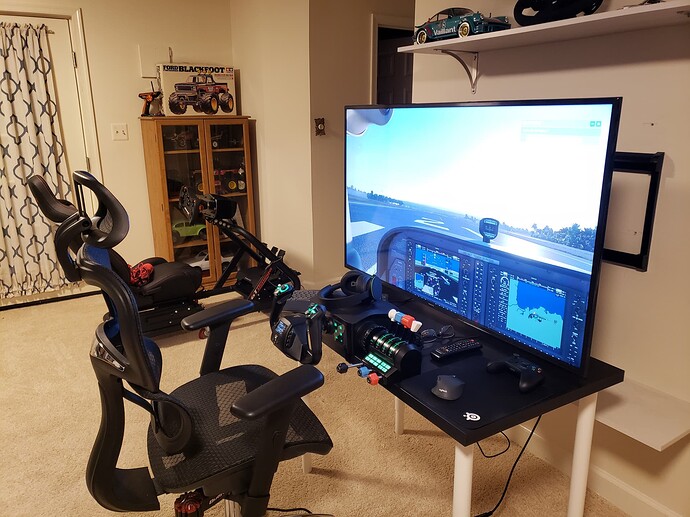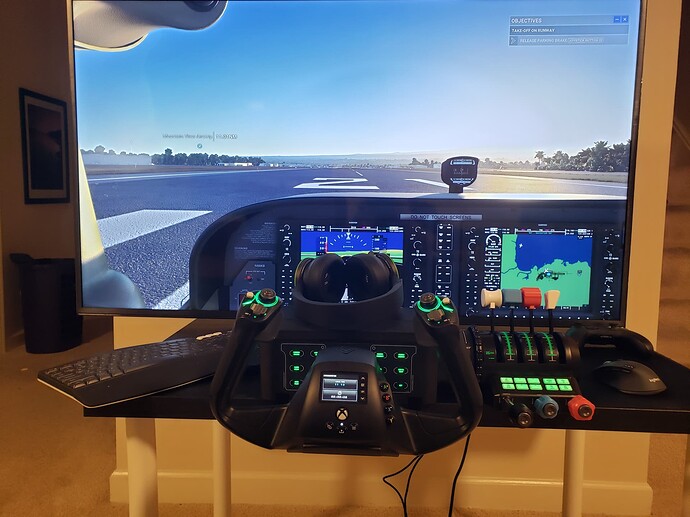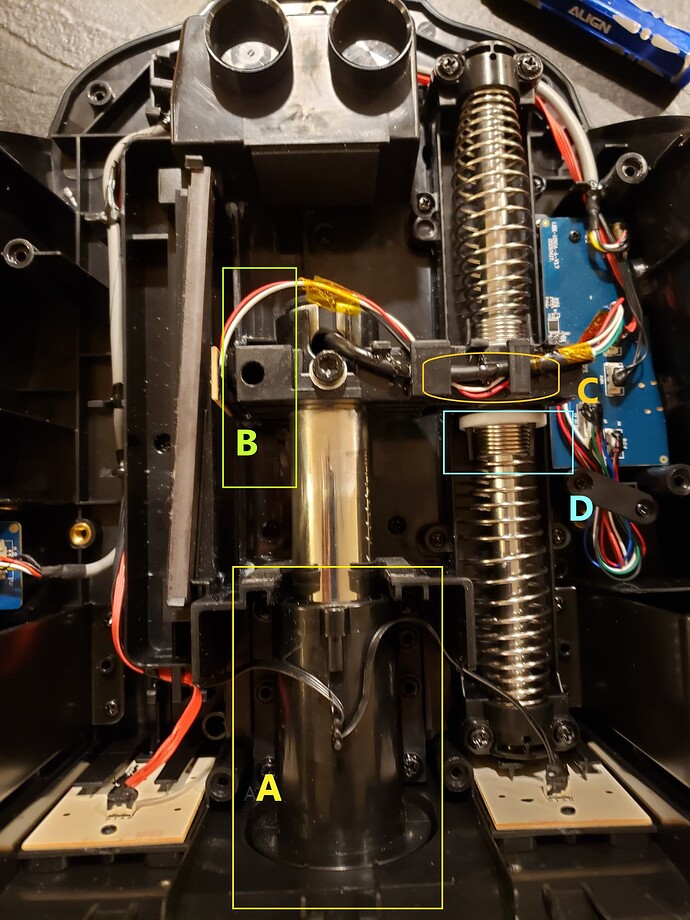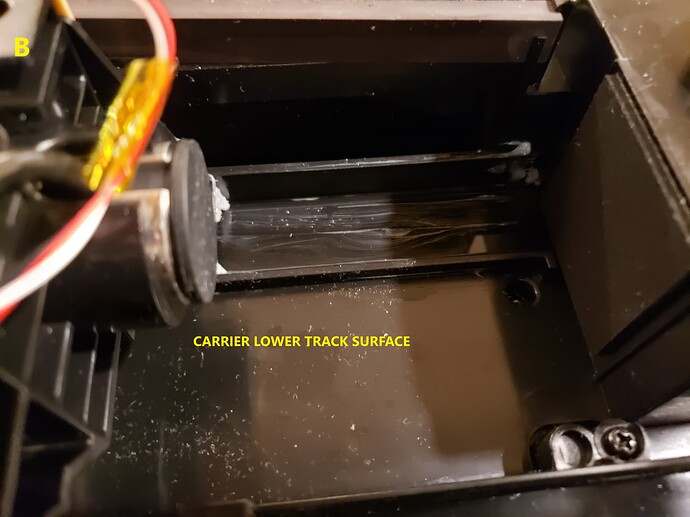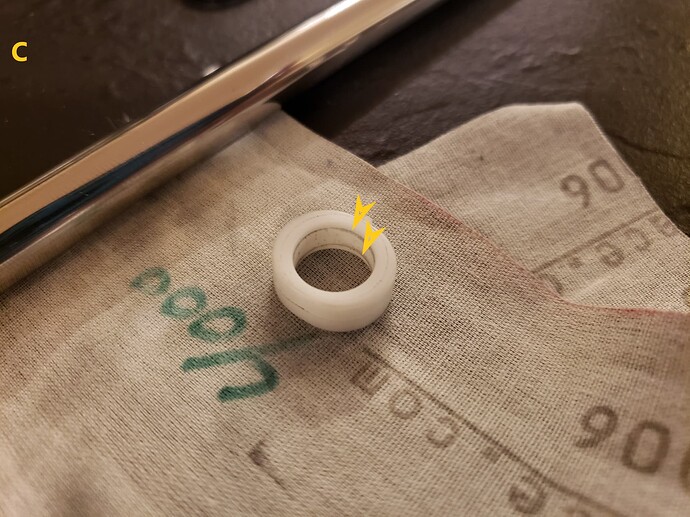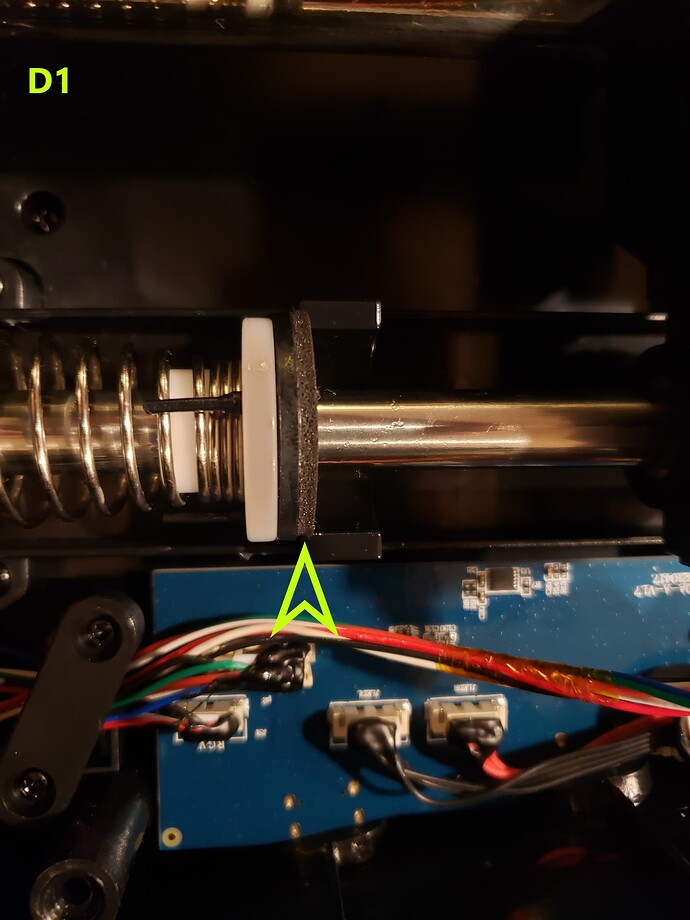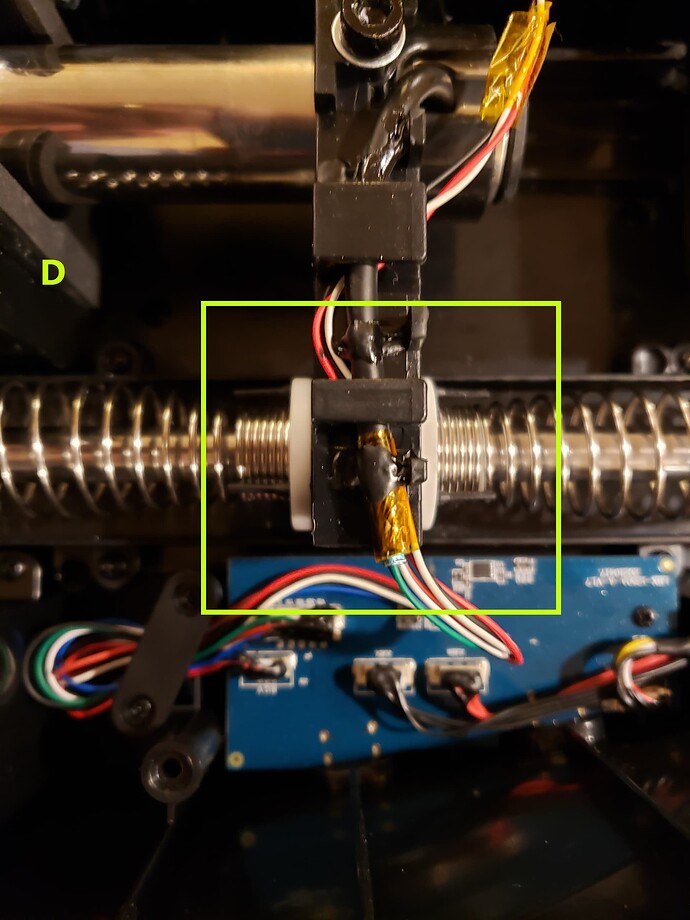I have set up the VC1 in default profile, did not change anything in the device (except setting it to xbox mode) and made all the control assigment in the Flightsim itself. The yoke stayed in default mode, neither 1engine nor two engine mode.
Is that what you mean?
If you refer to existing profiles in the Sim for your yoke, You can use the profile manager shown at the bottom of the page. It offers you to rename and also delete a profile of your choosing for the currently active controller.
24 hours with TBV1 yoke, hard time assigning and tricking it for TBM (my personal specs) … But Brooo, it is really good! ![]()
I get the same 4 axis issue the first time I scan.
This is as far as I think I’m going to go with it(barring pedals). Lightweight desk I can just unplug the buttkicker(amp behind the wall) and USB and rearrange the TV and mount up the racing rig, plug in the same buttkicker lead, usb and plug and become an F1 hero. Or just move everything and shove the tv back against the wall… Dropped the TV down from a ‘standard’ height to accommodate the racing rig, so needed some simple adjustable legs. It’s xbox, supposed to be simple so not going too crazy… TV also moves side to side so the yoke will always line up with a little push left/right ![]() Now to fill a few holes in the wall and get onto painting the basement…
Now to fill a few holes in the wall and get onto painting the basement…
I also took my V1 apart and did a bunch of minor modifications to smooth out the pitch. There are some design flaws and some TB attempted fixes that don’t work out too well. Now smooth as silk with no binding at all other than when putting way too much downward pressure on the yoke.
Even with a bunch of tweaks, I find elevator and rudder do well with about -37% sensitivity and a 3% dead zone. The V1 does not completely center every time(check your sensitivity screen) so without mods you probably need some slight dead zone and off center slightly to back elevator. So if you think you’ve leveled and set your trim, the yoke may not be 100 centered and the sponge pads settle and knock everything off a few % suddenly.
Cool. Did you happen to take any pictures of the innards?
Working on a write up of what I did. There are design flaws that are not easy to ‘fix’ by TB. Problem essentially is the sloppy yoke mount itself(by itself does not bind). It’s a few other tighter tolerance parts that bind up because of the sloppiness. I have 30 years experience with precision rc cars/helis/planes, modeling, and all other ‘guy’ stuff. This is why putting anything only on the exposed yoke shaft doesn’t do very much.
Interesting, thanks. I incorrectly assumed that the springs would be in-line with the yoke and on the same axis. Having the springs offset and then having some linkage back to the yoke itself seems like one area that is not helping…
Well it’s lunch so here goes. This is the problem with everything designed on CAD and not enough prototypes. First off, the peripheral is BRILLIANT, can’t imagine this much at this price on an xbox. Back when I chased so much less for thousands of dollars per year in computer gaming. No matter what my complaints/issues listed are, at this price point I do not expect metal or teflon bearings or anything else exotic. If this item worked PERFECTLY with upgraded internals and some more designer materials at $700+, I would still be in.
A: Is the main yoke support, with a nylon bushing surface inside. It has slop. By ITSELF, it does not bind. B: is the carrier/cassette that transfers load to the spring shaft(the small board to the left is the position sensor). This part sits in a track on the bottom, but has no support on top. This allows it to rocker its forces in a triangle with C/D spring shaft and bushings, which do NOT have much slop. And here within is where it binds.
In the world of CAD, I guess it was assumed that it would always be pulled back perfectly along the yoke shaft axis. The only ‘fix’ would be a major design change. Either support A would need to be made from a firmer metal material with better bushings, or support B would need to be molded into the top case to keep the shaft moving as designed.
Nothing explodes or flies apart if you take the case off. It can be clamped and used with no issues with the top case off. I spent a LOT of time with this as any modifications were not reversible, so did not want to go ‘too far’. in one test. So took this thing apart a lot of times. First was general examination, testing as is. A lot with the case off so I could fly around and IMMEDIATELY stop and see inside the box what I was feeling when not trying to make anything ‘happen’. Also, when ‘testing’ we tend to push the yoke ALL the way in and ALL the way out, when in reality we’re moving it 1/4" and holding, then gently releasing. All the ‘binding’ that feels so bad happens in a tiny amount of travel(at 200+ kias it’s not so ‘tiny’ to move the yoke 1/8"). THIS IS ONLY FOR MY PARTICULAR UNIT AND I DO NOT RECOMMEND ANY OF THIS…
For each part I also tested CLP, Ceramic grease, Lithium white grease, and various other lubricants. I settled on Ceramic R/C car grease(common in Tamiya RC cars). The materials are similar.
A: Yoke shaft, using a quality plastic safe grease(RC Ceramic) helps slightly. Fairly loaded on the inside. Outside only goes in a small amount. The inner bearing surface sees a higher load/angle. I did not disassemble any of it. There’s no real fix, but it helps. This does not fix binding.
B: Carrier/Cassette Track, a little grease on the contact surfaces. Just a dollop on each rail and let it find it’s way. It’s not in full contact everywhere. Helps a little bit. Also does not help binding, just fidelity.
C: The problem child itself. Inside the carrier on the spring shaft is a bushing. The spring shaft must be removed to access it. To see if this is the primary suspect, I outright removed it first and tested. The carrier slops up and down when turning but 80% better. There are slight ridges in the mold(see the wear marks). And that is after initial sanding. They BITE at the slightest off-angle. I started extremely mild and ended up opening it substantially, possibly a MM or more. Gave up on 3k/4k and went to 450 than 1200 then back to the finer stuff. I did some slight additional shaping to chamfer the edge and open the outer part slightly more, as the bushing rests to the outside of the force(some of it just me being fancy).
D: The spring support bushings have these spongy additional washers added(D1). They have adhesive on the backs but some has leached through the foam and where it rests in it’s center cradle, it slightly bites in and sticks a little(D1). D1 Shows the center point with the carrier moved out of the way. Again we are talking minutia of movement so we sense that tiny ‘stick’, react, and then feel the bind, etc. I dumped the sponges. The bushings on the spring shaft also have a little bite if the slightest bit off center(molding not the greatest and plain industrial nylon, not Teflon impregnated fancy stuff). So cleaned those up, nowhere near as dramatic as the carrier bushing. Had some minor binding issues with the same ridges in the mold. Just kept tweaking it until it didn’t grab at the slightest off-center movement. Lubricated with ceramic grease.
Another issue is the springs. Again designed in a vacuum of CAD, they are ‘perfectly’ designed to only work perfectly. I VERY CAREFULLY lengthened them about 10-15% for more positive centering. They are progressive wound and excellent for keeping the same ‘tension’ throughout the pull and you really need to be carefully lengthening a spring(can’t say I recommend trying this).
The spring shaft bushings needed the ‘slop’ to accommodate slop from the yoke. The design of the center spacer area still does not allow 100% centering, but I can’t imagine anything with a center point under tension from both sides to be 100% perfect, a controller joystick certainly does not. There is still a padded face to the spring stops, so it does have a tiny variable of it’s compression depending on how it’s ‘set’ to that center rest. So I go with 3% dead zone and still about 37% of negative sensitivity on pitch(and rudder). Seems to balance forces well with the aileron input for forces applied naturally(not when you just stare at a dead peripheral and play with it).
This has removed all binding for me, even when you hold a position and or have it at ‘rest’, where both the sponge sticks and the bushing(particularly the ridges in the molds) ‘bite’ back down on the shaft. If you are lazy and rest downward pressure on the yoke, it will firm up the pull quite a bit(as the yoke bushing also tightens down on the angle substantially), but doesn’t ‘chug’ and skip on the shaft any more. Easy to get lazy resting on the yoke flying trim and tiny corrections, playing with camera hats, etc for 20 minutes before initializing an elevator input. Anything remotely ‘normal’- less then cranking down on the yoke- is butter smooth to match the other inputs.
Again, I don’t endorse this, just a moment in time.
And to be honest it wasn’t terrible out of the box but I’m ■■■■ picky. Spent too much time in hobbies getting 5 different linkages to all have the same amount of resistance at every ball joint for something to sit neutral just under it’s own weight.
Technically just tweaking the 3 nylon bearings for more clearance (and the ones in the yoke shaft for less) with better molds and plastic compound could go miles to helping things without re-inventing the thing. Wouldn’t be surprised if those get updated somewhere along the line. Now for those pesky ‘loose’ throttle levers…
Wow. Nice work. Certainly not as easy as adding Nyogel to my Thrustmaster TWCS throttle, that’s for sure ![]()
We’ll I’m picky, have bought many an expensive top shelf helicopter rc component or $400 servos and still found myself taking ■■■■ apart.
I started first by emulating ‘wear’ by sanding that main bushing with 4k sandpaper in steps and polishing the spring shaft and getting nowhere before determining something needs to ‘go away’ to free it up. That’s when I just pulled the bushing out and worked my way back(and found the issues with the spring guides and foam pads as well).
For those not in the Turtle Beach simulation Discord; The new firmware released today, adding the reverser detents and support for the SIPS panel (with a little .exe file for PC).
Works beautifully, and the PDF linked in the announcement details all the steps necessary.
It’s pinned in the ‘Announcements’ section of the discord; Discord
For those not in the Turtle Beach simulation Discord; The new firmware released today, adding the reverser detents and support for the SIPS panel (with a little .exe file for PC).
Works beautifully, and the PDF linked in the announcement details all the steps necessary.
It’s pinned in the ‘Announcements’ section of the discord; Turtle Beach Simulation
Thanks for the link, a little disappointed they haven’t emailed that out and I had to find out about it from here/join yet another discord.
I have the reversers bound per their documentation, and it’s working as expected. You need to be sure you are setting the right “on press” and “on release” actions for the settings. Couple this with the Controls settings being buggy to begin with, go back and check your settings one last time before saving. Mine was not saving the “On release” the first time.
Separate question, does MSFS have a key bind for setting the props to feather in the Caravan? I couldn’t find any setting that moved the propeller lever to feather, so I couldn’t bind that to the new detent feature on the V1F.
I’ve been looking for this one as well (but for the Twin Otter), so if anyone finds a way, I’d be interested in hearing this as well.
Should be Toggle Propeller Reverse Thrust, there’s only one so you can’t do it individually.
Interesting, I will try that. I didn’t think to bind this due to “reverse thrust” being in the name. I assumed it was something other than feather.
That’s for the Otter, not necessarily the Caravan.
I tried updating to the new firmware Ver 1.1.0. About 6% in, I got a message on my controller “FLASH DATA IS ERROR. PLEASE DOWNLOAD DATA”, followed by “Firmware downloading”. And it progresses till about 65% before erroring our, saying “Firmware Update Has Failed”. Now I have a controller that does not work and is stuck in update mode. @JamesTBS6584 or any others who can help?
I am on Windows 10. Points to note: My Turtle Beach Control Center was updated through MS Store yesterday and I had some BIOS updates on my laptop yesterday. I have tried uninstalling and re-installing the Turtle Beach Control Center app to see if it helps, but to no avail.
